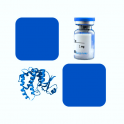
- Remove this product from my favorite's list.
- Add this product to my list of favorites.
Products
Viewed products
Newsletter
 |  |  |  |  |  |

Background
Colony stimulating factor 1 receptor (CSF1R) is also known as macrophage colony-stimulating factor receptor (M-CSFR), CD115 Cluster of Differentiation 115 (CD115), C-FMS, CSFR, FIM2, FMS, and is a member of the typeⅢ subfamily of receptor tyrosine kinases (RTKs). CSF1R is a receptor for a cytokine called colony stimulating factor 1, The protein encoded by the CSFR1 gene is the receptor for colony stimulating factor 1, a cytokine which controls the production, differentiation, and function of macrophages. This receptor mediates most, if not all, of the biological effects of this cytokine. Ligand binding activates CSFR1 through a process of oligomerization and transphosphorylation . Mutations in CSF1R are associated with chronic myelomonocytic leukemia and type M4 acute myeloblastic leukemia. Increased levels of CSF1R1 are found in microglia in Alzheimer's disease and after brain injuries. The increased receptor expression causes microglia to become more active. Both CSF1R, and its ligand colony stimulating factor 1 play an important role in the development of the mammary gland and may be involved in the process of mammary gland carcinogenesis.
Source
Recombinant Cynomolgus M-CSF R, His Tag (CSR-C52E1) is expressed from human 293 cells (HEK293). It contains AA Ile 99 - Pro 596 (Accession # G7P8P1).
Predicted N-terminus: Ile 99
Molecular Characterization
This protein carries a polyhistidine tag at the C-terminus.
The protein has a calculated MW of 57.1 kDa. The protein migrates as 70-100 kDa under reducing (R) condition (SDS-PAGE) due to glycosylation.
Endotoxin
Less than 1.0 EU per μg by the LAL method.
Purity
>95% as determined by SDS-PAGE.
FormulationLyophilized from 0.22 μm filtered solution in PBS, pH7.4 with trehalose as protectant.
Reconstitution
Please see Certificate of Analysis for specific instructions.
For best performance, we strongly recommend you to follow the reconstitution protocol provided in the CoA.
Bioactivity
Please refer to product data sheet.
Storage
For long term storage, the product should be stored at lyophilized state at -20°C or lower.
Please avoid repeated freeze-thaw cycles.
This product is stable after storage at:
-20°C to -70°C for 12 months in lyophilized state;
-70°C for 3 months under sterile conditions after reconstitution.
(1) "Propranolol Promotes Monocyte-to-Macrophage Differentiation and Enhances Macrophage Anti-Inflammatory and Antioxidant Activities by NRF2 Activation"
Maccari, Profumo, Saso et al
Int J Mol Sci (2024) 25 (7)
(2) "Radiofrequency Combined with Intratumoral Immunotherapy: Preclinical Results and Safety in Metastatic Colorectal Carcinoma"
Seguin, El Hajjam, Legagneux et al
Pharmaceutics (2024) 16 (3)
(3) "The causal association between circulating cytokines with the risk of frailty and sarcopenia under the perspective of geroscience"
Wang, Wang, Wan et al
Front Endocrinol (Lausanne) (2024) 15, 1293146
Showing 1-3 of 1451 papers.
Follow us